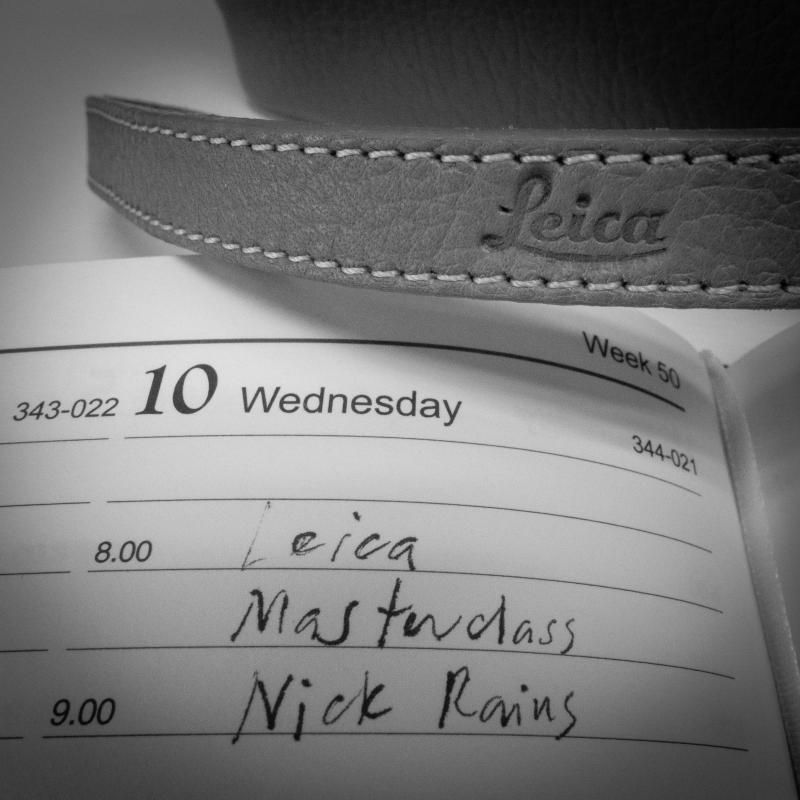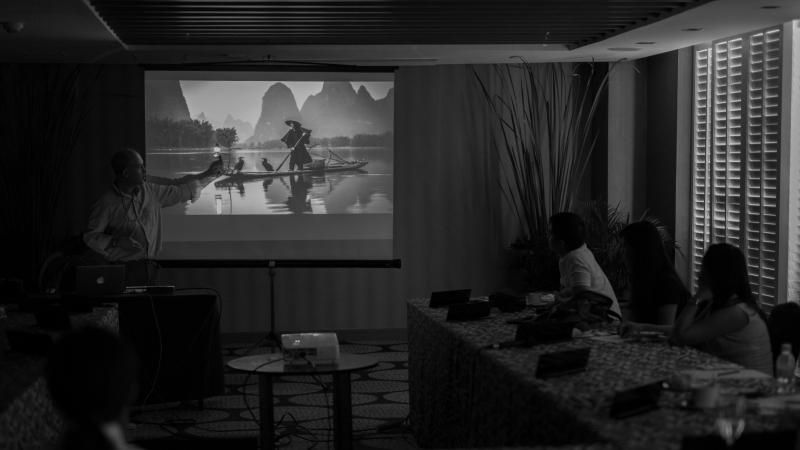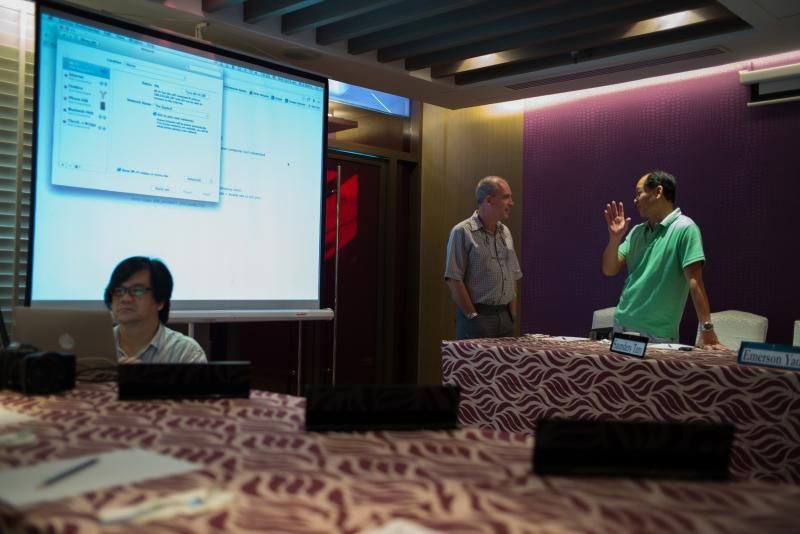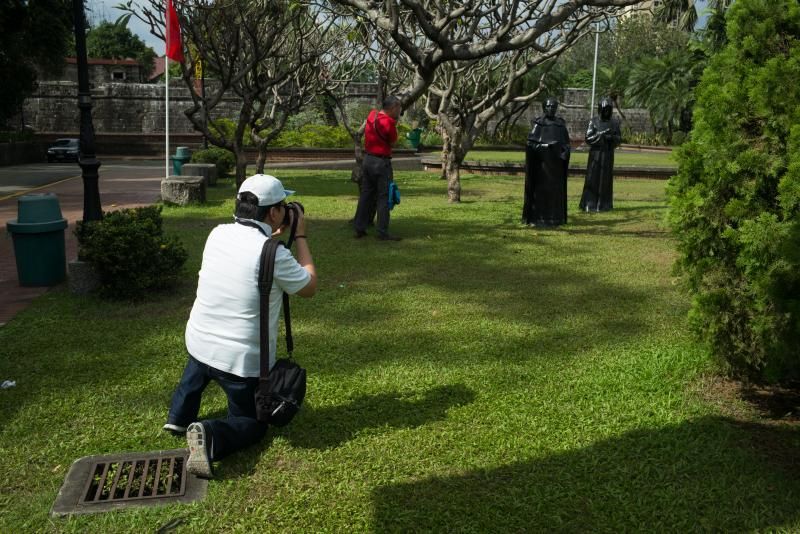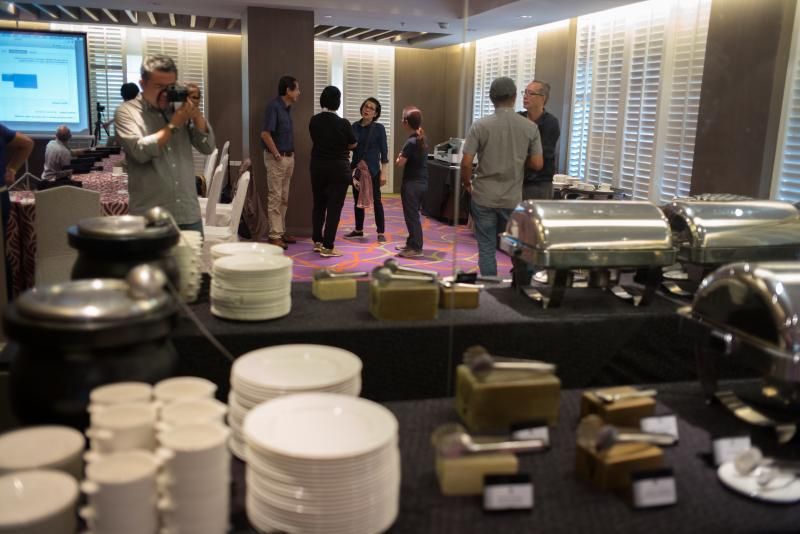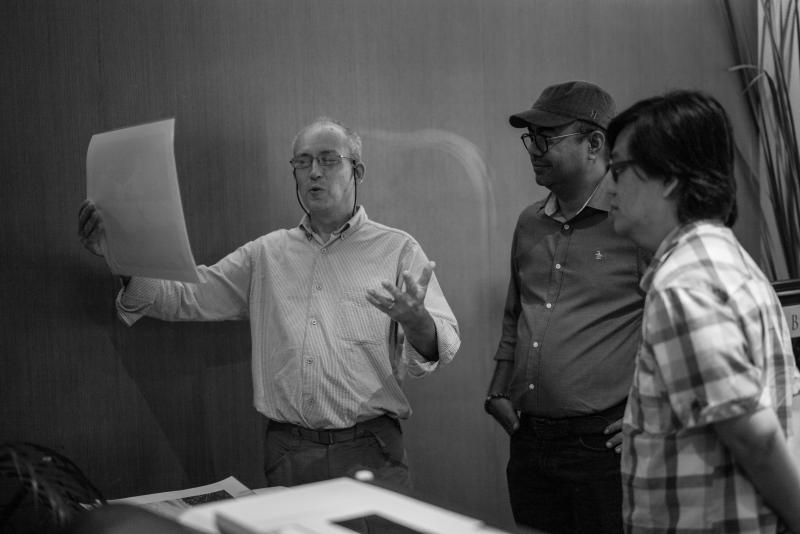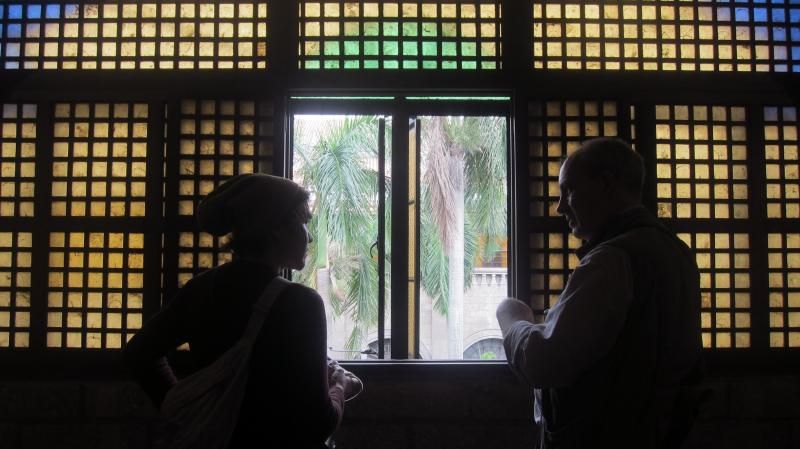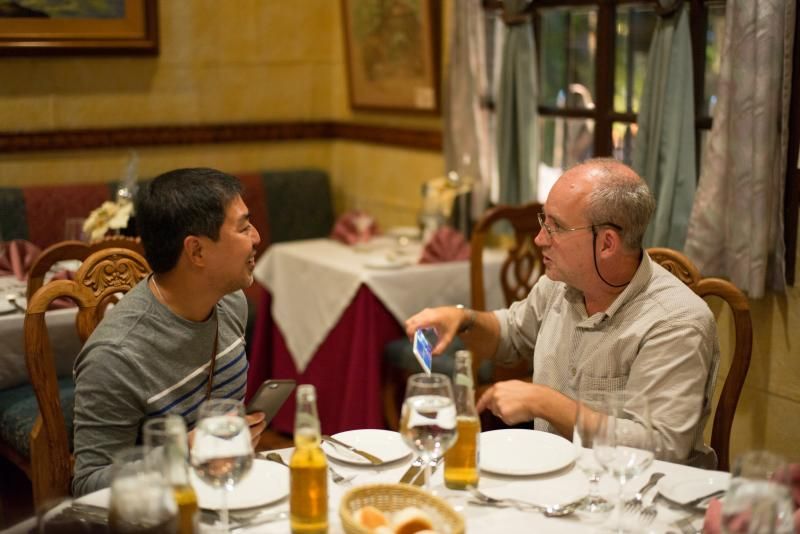Manila, 2014
I have always been curious about Leica Akademie masterclasses and how they might differ from other photography “workshops” that I’ve attended over the years. The website states that “The mission of the Leica Akademie is to increase the pleasure of photography, share knowledge and bring a total Leica experience to a new generation of photographers.”
Does it? Well, let me try to break it down for you and see if the Nick Rains masterclass that I attended ticks all the boxes in that mission statement; see if Leica really walks the talk.
… increase the pleasure of photography
People enjoyed the workshop for various reasons. And this is where you can really gauge how good the instructor is based on how he can bring together a diverse group of participants. And by diverse, I mean really diverse. From one end of the spectrum, you had people there who photographed for a living and have shot with all kinds of light boxes including medium format cameras like Hasselblad and the Leica S to name a few. On the other end, you had people with old point and shoot cameras who didn’t know that there were other letters in the shutter wheel other than “A”.This is an all-encompassing promise that may mean many things to many people. Value, is after all, very subjective. Having said that, I did talk to a lot of the participants in both travel sessions to get an even feel and also to cross-check my biases against workshops. Mind you, I knew several people in the crowd and if you folks have been hanging around the local photography scene for the past decade or so, you’d realize that the class had its share of critically-minded students which, yes, included yours truly.
Nick explaining how he used the lantern to illuminate the face of a cormorant fisherman
Nick reeled us in with a beautiful slideshow of photographs from his travels. With the lights off and soothing music streaming off his newly-bought Bose Soundlink, it felt like I was there enjoying the great outdoors momentarily forgetting that my head was being freeze blasted by the hotel’s air-conditioning. Well, I guess, it did make Nick’s Mongolia series a bit more realistic :-p
But the real “pleasure of photography” was felt in the next part of the Akademie’s mission statement.
… share knowledge
Workshop instructors are a crapshoot to be honest. There are some cool photographers who really have no business teaching. Then there are those who put meat in that saying “those who can’t, teach”.
Well, Nick Rains can shoot and, yes, can he teach. His style is very relaxed and you don’t get that feeling that you’re being force fed a certain way of doing things. He will share with you his preferences but always in a context that you do have other choices. I’d say he had more of a mentoring approach. While he does set expectations in the beginning that during the course of going around Intramuros that he’ll leave you alone to discover your own photographs, I’ve seen him approach participants who seem to be experiencing a difficult time trying to capture a scene.
I know because I was one of them. I was standing in front of the Gomburza statues staring at it for the longest time when he approached me from out of the blue. He must have gotten this impression that I was crapping my pants trying to compose my image because sweat was profusely streaming down my forehead when all it really was was me waiting for another participant to get the hell out of my field of vision. He suggested ways of trying to approach the scene; wait for the sun to get behind the clouds so that the light would be a bit softer. Which led me to asking what kind of light he preferred.
I already knew based on his slideshow but he validated my observations that he preferred soft light for a reason different from what Steve McCurry shared with me in a previous outing. While Steve preferred a lot of mid tones and just hated strong contrast, Nick preferred soft lighting because it made for a more malleable image in Lightroom. And when I say soft light, I don’t mean light that’s flat. Sure all your information is within a certain bell curve in the histogram but what Nick prefers, if I’m not mistaken, is light that provides a lot of gentle kick in the mid tones. I checked his images in his website and it seems to confirm what I thought. His images have a serene feel and supports what he said when he introduced himself; that he wasn’t a photojournalist or that he revels in capturing thought-provoking scenes. He prefers capturing beauty and it really shows in his photographs.
I don’t think I’ll have enough space to expand on this “share knowledge” bit so I might make that into another article incorporating what Nick told us with regard travel tips. Just a short word on these so-called travel tips.. When somebody like Nick tries to distill 31 years of shooting experience into a few tips, it gives one a preview as to what people like him value the most or what’s on top of a seasoned travel photographer’s mind when they prep for an assignment. It also mirrors, in a very subtle way, the kind of photographer that they are.
Nice thing about these workshops is that you get a chance to play with nice toys. A participant with a Leica S.
Take for instance that age-old issue about forgiveness versus permission with regard taking somebody’s photograph. There is no right and wrong here but in what direction you sway, does, in a small way, give shape to what you think is important. Nick favors asking for permission and explains how spending time with his subjects gives him access to the more intimate aspects of their lives. He made an example of this by showing us a photograph of a man in a very fatherly moment with his son inside their home, a Mongolian tent known as a Yurt. The image was very touching and there was no way he could have taken that photograph if they didn’t let him in their lives. A respect for culture and diversity and the human condition is what it is and is what makes Nick Rains, well, Nick Rains.
Friends and about-to-be friends chatting away before the start of the class
I want to expound more about Nick with comments and observations from the participants. I got introduced to a quiet socio-political figure in the room because one of her seat mates had the new D-lux (type 109) and the Leica General Manager knew that I was very interested in it. Breaking the ice with genuine interest, I remarked that I never really knew that she was into photography. After which I asked what she thought about the masterclass.
A lovely conversation ensued and she told me that she really liked Nick because unlike other instructors, Nick shares. There were no secrets with Nick and I think this is one of the things that separates good photographers from the great ones. The great ones are very confident and secure about themselves such that they don’t mind sharing their secret sauce (which is an actual script of his so named in Lightroom in his computer. It's an automated routine that sets the look of a photograph he's working on to a preferred base of initial settings).
Nick sharing his printing and paper preferences
To give the sharing aspect a bit more dimension, my friend was very interested to see what Nick had to say about the quality of his prints as the former brought a small part of his portfolio to the session. He was able to get some quality time with Nick on Day 2 and showed him his prints. If anything, any type of learning session brings about it a facet of trying to see how far one is from the gold standard. And in that morning of December the 11th, a gold standard of printing, Nick Rains, was in the house. Gold standard? Sure he is… he belongs to a hallowed list of Ilford masters alongside my idol Sebsatiao Salgado! Anyway, this is the part where Nick shines… he looks at my friend’s prints and tells him that he has nothing more to learn! I was floored when I heard it. More so when he said later on in the van enroute to dinner that he wouldn’t mind having a particular print of his hang in his wall. Well, he didn’t mention what wall. It might have been the bathroom wall. Just kidding ![]()
As you can see, it doesn’t faze him to recognize good talent for what it is. This gentleman is quite secure about himself knowing that he can be magnanimous about these things.
A newbie with a Leica C in hand (hidden from view)
Another dimension to this sharing aspect was the invaluable presence of Sim, Leica Singapore business manager. Now, between Sim and Nick, the conversation really got interesting with Leica. But then see, I can’t share that with you. So next time a Leica masterclass comes up, you folks know what to do. Ok enough of being a Nick Rains fan boy. There’s another aspect of sharing that doesn’t necessarily have anything to do with photography but with the participants that get attracted to this kind of thing. I had the privilege of spending a bit of time with Lucerne’s managing director during our walk-about in Fort Santiago (Lucerne is the loose equivalent of, say, a Sincere in Singapore). We got to talk about the watch industry, how Leica came about in Manila, etc. He even mentioned that Rolf Schnyder used to live here during his younger days (there's a bit of trivia for you UN fans). It was a very pleasant chat and one that can be used as basis for another interesting article. Once I’ve gathered my wits about me, I told Leica Manila’s marketing head that I’d like to get an opportunity to interview him at some convenient date. I wish I could share what we talked about but that will have to be for another time.
Sim, Leica Singapore business manager
By now, you’re probably asking what the advanced amateurs and pros thought about the masterclass. Great food! Hahaha! Seriously, one of them remarked that it was always good to be reminded of certain basics that one tend to forget after photographing for a long while. I for one appreciated very much how he developed his lecture around his Mongolia series, pairing lessons with photographs in a measured progression that ultimately led to the whole being built on the sum of its parts. I think it was subtle genius to present travel photography in this manner.
It’s also good to point out that even if one considers oneself as advanced, that across the image-building process, there will be parts of it that one will be good at and parts where improvements can still be done. I was particularly interested in his approach to using Lightroom. It was the closest thing to a big picture perspective that I’ve always felt I lacked. He said that if in order for LR to work, that you need to commit to it and a lot of other things that revolved around that one particular statement.
All of these things that I just shared with you form part of what Leica said in the third part of its mission statement and that is…
… bring a total Leica experience to a new generation of photographers
The ladies of Leica Manila, Edith, Leica GM and Sharllene, Leica marketing head
Which brings us to the icing on the cake. Total Leica experience undoubtedly refers to the sense of occasion that it bestows on its masterclasses. It is respect towards the learning process and its participants that manifests itself from the moment you walk in the door and register to the moment goodbyes are exchanged at the end of each class. Little things like well-thought out seating arrangements definitely add to the experience. You get that feeling that they took extra steps to know you.
The itinerary was also clearly laid out with German precision. Provisions for weather were included in their backup plans just in case Nick lived up to his last name (he flew in just as a typhoon was making its way out of the country).
Of course, things didn’t exactly run smooth 100% of the time but then for a first time Leica Akademie masterclass in Manila, it went pretty well.
that word “masterclass”
participants at work
Before closing this write-up, I’d like to share what I talked about with Nick and Sim regarding the use of the word “masterclass” in the Akademie sessions. While the enthusiast realizes that the word masterclass refers to the instructor and a particular level of teaching quality, it might be worthwhile for HQ to consider if the word has a tendency to dissuade potential students from enrolling as it can be intimidating to the outsider to be honest. Sim said that it was a valid point and would ask Singapore about it. Just to let you guys know that what I said wasn’t unfounded, I learned a few days after the class that, indeed, there was a participant in the class who almost did not enroll because he/she thought that it was going to be for professionals. Leica Akademie might consider using the word masterclass for perhaps advanced sessions and something else for general-purpose ones. Leica needs to realize that while professionals or advanced amateurs will not be fazed by these things, a big part of their clientele, those who buy the C’s and the Ts and the Dluxes, from where the real money comes from to support specialist items like a Leica M7 or a Nocti, maybe alienated. It would be a shame from a marketing standpoint as these classes can be used to educate the younger generation about Leica’s other offerings.
a parting word on the Leica Akademie masterclass and workshops in general
Ask and ye shall receive
Just like in any learning session, the burden of maximizing ones tuition fee lies on the participant more than it does on the instructor. After all, one doesn’t go to a good college and expect to graduate with honors without studying hard. In this case, for example, you’ll get the most out of a session if you ask questions. I had to mention this because a participant relayed to us some of the reactions of his classmates in another Akademie masterclass that he just attended a few days prior in Tokyo. He said that some of them were a bit disappointed because there wasn't much teaching that happened. I knew of the instructor and asked, "but they knew who he was, right? and that expectations were set early on?" To which he said, yes. So there you have it. You plunk in serious money for a class so I'm thinking part of the responsibility to do due diligence is with the participant. It's all about expectations and setting them very low :-p
What that participant shared with me about his Tokyo experience did ring some warning bells from a corporate standpoint. I did wonder if the Akademie had a set of standards that the regions need to follow; how far it's structured and templated down to corporate logo on a presentation slide, for example. I get the impression that Leica as a global brand needs to work on this to provide a seamless Leica experience whatever the location. From what I've seen on this site regarding how the likes of JLC or AP do their own masterclasses, there is definitely room for improvement for Leica in this aspect.
Going back to this particular class, the participants told me on separate occasions that the reason for attending a masterclass is not to learn technical things. One gentleman said that he attended to get inspired. Another said that you attend a masterclass to see how a “master” does it. In this case, how Nick does travel photography and try to get his slant on it.
After having attended a session and having observed the other, I’d say that Leica was able to tick all the boxes in its mission statement and then some. A lot of great friendships were made and, at the very least, I think this is reason enough to sign up for a masterclass session.
And that's how you end a session… over dinner with a few bottles of beer 
Thanks for reading and a happy holidays to you all!
Echi


